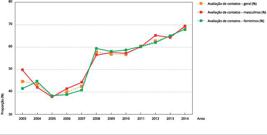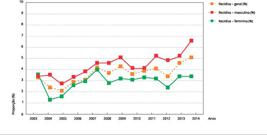The aim of this study was to analyze operational indicators and time trends in leprosy control from a gender perspective in Bahia State, Brazil, from 2001 to 2014. This was a time series study based on epidemiological data on leprosy from the Brazilian National System of Diseases of Notification, using joinpoint Poisson and polynomial regression. Of the 40,054 new cases of leprosy, 47.1% of the recorded contacts were not examined, with a significant upward trend, especially in women (average annual percentage change - AAPC = 5.6; 95%CI: 3.5; 7.7) when compared to men (AAPC = 3.0; 95%CI: 0.5; 5.6). The proportion of cure in the 2003-2014 cohort was 85%, with a downward trend, especially in men (AAPC = -0.5; 95%CI: -0.9; 0.0), compared to women (AAPC = -0.4; 95%CI: -0.7; -0.1). Treatment dropout rate was 5.5%, with a more significant downward trend in women (AAPC = -4.9; 95%CI: -8.7; -1.1) than in men (AAPC = -2.7; 95%CI: -4.4; -1.0). Relapse was recorded in 3.8% of all the entries during the same period; women showed a significant downward trend (AAPC = -2.2; 95%CI: -3.3; -1.0) and men a significant upward trend (AAPC = 4.9; 95%CI: 2.9; 6.8). Polynomial regression analysis was consistent with joinpoint regression. Leprosy in Bahia State shows operational indicators with significant magnitude and time trends, especially in the male population. Health services’ insufficient performance in conducting contact surveillance and longitudinal care reveal various dimensions of vulnerability.
Leprosy; Time Series Studies; Gender and Health

 Thumbnail
Thumbnail
 Thumbnail
Thumbnail
 Thumbnail
Thumbnail


